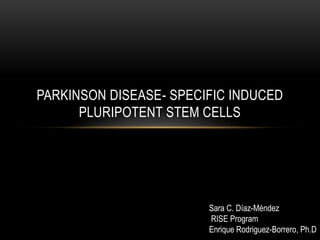
Parkinson's Disease Stem Cell Therapy
- 1. PARKINSON DISEASE- SPECIFIC INDUCED PLURIPOTENT STEM CELLS Sara C. Díaz-Méndez RISE Program Enrique Rodriguez-Borrero, Ph.D
- 3. Parkinson's is a progressive movement disorder that usually strikes after age 50. Parkinson’s involves the malfunction and death of vital nerve cells in the brain, called neurons. The neurons that die in Parkinson's Disease connect a structure in the brain called the substantia nigra to another structure called the striatum. EFFECTS:
- 4. Alternative Approaches for treating Parkinson's disease: • For many years, doctors have treated Parkinson's disease patients with the drug levodopa, which the brain converts into dopamine. Although the drug works well initially, levodopa eventually loses its effectiveness, and side-effects increase. Surgery, such as deep brain stimulation with implanted electrodes, is used to treat advanced symptoms. But it does not slow down or reverse the damage to nerve cells in the brain. Over time, the symptoms often get worse despite treatment. Pluripotent embryonic stem cells have been recently used by scientists and are under investigation.
- 5. WHAT ARE PLURIPOTENT STEM CELLS? Stem cells are defined by two properties. First, they can ‘self-renew,’ that is, they can divide and give rise to more stem cells of the same kind. Second, they can mature or ‘differentiate’ into specialized cells that carry out a specific function.
- 6. PROBLEM • Recent studies in rodents with embryonic stem cells to replace dopamine producing neurons in the brain have develop tumors as a side effect.
- 7. CHALLENGE Use a different type of pluripotent stem cells that won’t be rejected from a person's body due to their immune system. Many scientists and members of the public have ethical issues with the use of pluripotent stem cells from human embryos or fetal tissues.
- 8. HYPOTHESIS Using pluripotent cells from the patient’s skin to produce pluripotent embryonic like cells and from these cells generate the dopamine producing neurons that will reduce the risk of immunological rejection of the new neuron cells.
- 9. METHODOLOGY 1. I will use a large number of rodents that will allow my results to be statistically significant. First I will locate the midbrain area in rodents involved in dopamine production. 1. Induced pluripotent stem (iPS) cells are going to be made from a rodent’s skin cells in the lab, and then used to make dopamine- producing neurons. - To make a specific type of cell in high numbers, scientists expose the stem cells to a cocktail of chemicals that mimic what they would experience during normal development. The resulting cells also carry more of the molecular markers that characterize dopamine-producing cells in the brain.
- 10. METHODOLOGY • 3. Surgically I will introduced the generated dopamine producing neurons in the midbrain area, which is where dopamine neurons are normally located. Since a single, well-defined type of cell is affected, it is possible to treat Parkinson’s by replacing the lost nerve cells with healthy new ones. • 4. Their physical and motor skills will be observe to evaluate the progress of the disease. Laboratory blood analysis will be performed to monitor the progress of the disease.
- 11. FUTURE INVESTIGATION • Studies will be needed to make sure the cells are safe and would not cause tumors in the brain.
- 12. EXPECTED OUTCOME • This will improve the quality of life of elderly people affected by Parkinson's Disease and extend their life expectancy. It will also reduce the cost of caring of elderly people.
- 13. REFERENCES: • "All About Parkinso's Disease." . Marc, 25 Apr. 2014. Web. 21 June 2014. <http://coloradodementia.org/category/parkinsons-disease-2/>. • "Parkinson's Disease." . NIH Senior Health, 1 June 2012. Web. 1 June 2014. <http://nihseniorhealth.gov/parkinsonsdisease/whatcausesparkinsonsdisease/01.html>. • "STEM CELL RESEARCH AND PARKINSON’S DISEASE." . Parkinson Society Canada, 1 May 2009. Web. . <http://www.parkinson.ca/atf/cf/%7B9EBD08A9-7886-4B2D-A1C4- A131E7096BF8%7D/stem%20cells%20-%20en.pdf>. • "Reprogramming: how to turn any cell of the body into pluripotent stem cell ." . Euro Stem Cell , 14 Dec. 2012. Web. . <http://www.eurostemcell.org/factsheet/reprogramming-how- turn-any-cell-body-pluripotent-stem-cell>. • "Stem Cells and Diseases." . National Institude of Health, 1 Dec. 2013. Web. . <http://stemcells.nih.gov/info/pages/health.aspx>.
